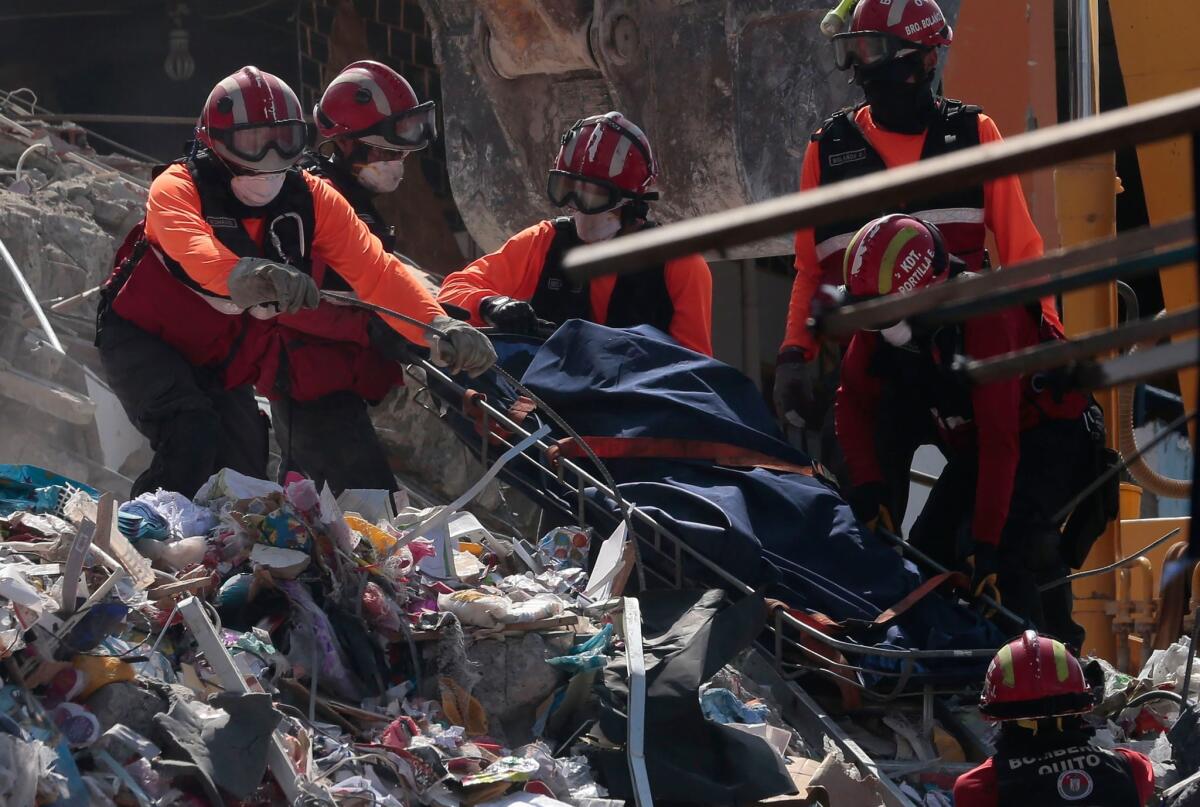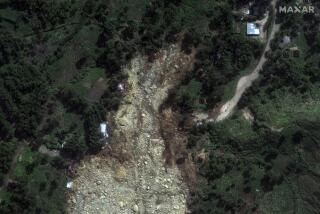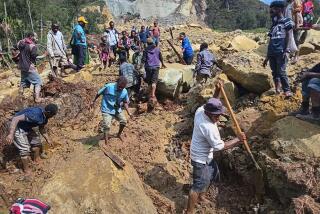Ecuador quake death toll now 553 and set to rise further

Rescuers remove a corpse from the rubble in Manta, Ecuador, on Wednesday.
Reporting from Guayaquil, Ecuador — The death toll from last weekend’s earthquake rose to 553 on Wednesday afternoon, as the government intensified relief efforts by sending truck caravans and cargo aircraft to deliver badly needed food, water, tents and bedding to shattered cities along the country’s Pacific coast.
It was unclear how many people were still missing. The attorney general said 1,700, while the Defense Ministry put the figure at 231. More than 4,500 injuries have been reported.
Although the government noted that 54 people had been pulled alive from wreckage by teams in various cities, the fatality count is expected to climb significantly.
See more of our top stories on Facebook >>
Thousands of survivors continued to sleep in parks and outdoor arenas. There have been more than 540 aftershocks, including two close to the epicenter -- near the coastal town of Muisne -- early Wednesday of magnitudes 6.1 and 6.3. The temblor Saturday was magnitude 7.8.
Parts of the disaster zone remained in dire need of drinking water, and the country’s bottlers have turned over their plants to the government, which has also sent six mobile water purification systems to hard-hit Manabi province.
President Obama telephoned his Ecuadorean counterpart, Rafael Correa, on Tuesday and sent a planeload of supplies. The U.S. has not had an aid office in Ecuador since 2014.
In a televised address to the nation Wednesday afternoon, Correa said Ecuador was facing its worst disaster since a 1949 quake, which destroyed much of the city of Ambato and killed 5,000.
He noted that difficulties communicating with some towns were hindering efforts to determine the full extent of the damage.
The $3-billion figure he gave Tuesday was just an estimate, and a full accounting will take six weeks, he said.
In the beach town of Canoa, 85% of buildings were destroyed, the president said. The town, with a population of about 4,500, is popular with foreign tourists and shows up on lists of best retirement spots for U.S. seniors.
The nearby coastal town of Bahia de Caraquez “will have to be rebuilt almost entirely,” and damaged hospitals there and in the city of Chone will have be to “destroyed and rebuilt with new ones,” Correa told viewers.
“We have seen human dramas, but with our tears we will grow the future,” he said.
Relief is flowing in from all parts of Ecuador and many neighboring countries, with 4,000 doctors and 4,500 police officers sent to the disaster zone. About 42,000 troops are on call if security becomes a problem.
Here in Guayaquil, the country’s largest city with a population of 3 million, the death toll stands at two. Of 243 apartment buildings that were damaged, 20 will have to be demolished, authorities said.
Located just south of the quake’s main impact zone, the city has become an outpost for the relief effort and a refuge for victims fleeing destruction. It is jammed with traffic, made worse by the collapse of several freeway bridges and a tunnel.
A caravan of 80 trucks loaded with supplies departed Guayaquil on Wednesday morning for the city of Manta. It was organized by the mayor of Guayaquil, Jaime Nebot, a harsh critic of Correa who nonetheless said he was staying above politics.
“This is not the time be politicking or to try to take the stage,” Nebot said. “I’m more of use here in Guayaquil working. What’s needed is maturity and the will to help.”
Special correspondents Jaramillo Viteri and Kraul reported from Guayaquil and Bogota, Colombia, respectively.
ALSO
How Japan came to rank worse than Tanzania on press freedom
A police officer killed a man over a cup of tea in Egypt
Death toll in Taliban bombing and gunfight rises to 64; Afghan president calls the attack ‘inhuman’
More to Read
Sign up for Essential California
The most important California stories and recommendations in your inbox every morning.
You may occasionally receive promotional content from the Los Angeles Times.










